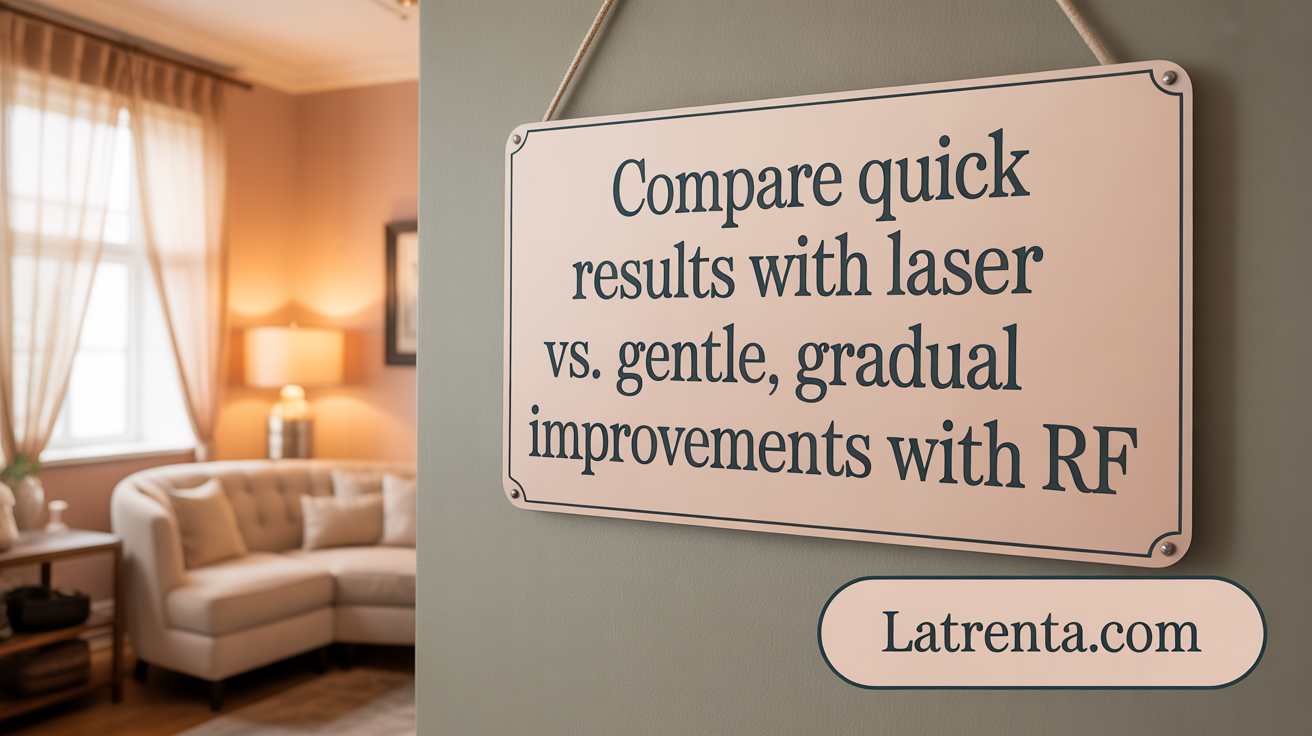Choosing Your Path to Radiant Skin
With numerous skin rejuvenation options available today, understanding the core differences between laser and radiofrequency (RF) treatments is essential. Both technologies promise improved skin texture, tightened contours, and a youthful glow, but choosing the right method depends on your skin type, concerns, and lifestyle. This article unpacks how each technology works, their benefits, drawbacks, and clinical evidence, helping you decide which treatment aligns best with your skincare goals.
How Laser and Radiofrequency Technologies Work for Skin Rejuvenation

How do laser and radiofrequency (RF) technologies work for skin tightening and rejuvenation?
Laser and RF treatments are advanced methods used to improve skin appearance by stimulating the natural production of collagen, the vital protein that maintains skin strength and elasticity. They operate by delivering targeted energy deep into the skin layers.
RF therapy uses radio waves to generate heat in the dermis, the skin's middle layer, usually heating tissues to about 50-75°C. This controlled heating causes existing collagen fibers to contract and stimulates the production of new collagen, gradually tightening and lifting the skin.
Lasers employ concentrated light energy to heat or remove damaged skin tissue. Depending on the type, laser treatments can be ablative, which remove the outer skin layers, or non-ablative, which heat the underlying tissues without damaging the surface. This thermal process encourages collagen formation and skin renewal.
Both techniques are usually non-invasive, with treatment sessions lasting approximately 30 minutes to an hour. Patients often experience minimal discomfort, with common temporary side effects like redness, swelling, or mild soreness.
The choice between laser and RF devices depends on individual skin concerns, treatment goals, and skin type. Professional guidance ensures the procedures are performed safely, maximizing benefits such as improved skin firmness, reduced wrinkles, and a more youthful, revitalized appearance.
Skin collagen stimulation
Central to both treatments is collagen stimulation. RF heating causes existing collagen fibers to shrink and remodeling to occur, stimulating the growth of new, stronger fibers over time.
Laser treatments induce controlled micro-injuries or heat, which signal the body to produce more collagen as part of the healing process. Over multiple sessions, this leads to noticeable skin tightening and improved texture.
Treatment duration and discomfort levels
Most sessions are relatively quick, typically lasting between 30 minutes to 60 minutes. Discomfort varies but is generally mild, often described as a warming sensation or slight pinching.
Patients experience minimal downtime, with redness or swelling often resolving within a few hours to days, depending on the intensity of the treatment.
Importance of provider expertise
The effectiveness and safety of laser and RF treatments depend heavily on the skill of the practitioner. Proper device calibration, settings, and technique are crucial in minimizing risks such as burns, pigmentation changes, or scarring.
Working with an experienced, trained provider ensures personalized treatment plans aligned with your specific skin type and concerns. This professional oversight helps optimize results and ensures the procedure’s safety.
| Treatment Type | Typical Duration | Recovery Time | Main Benefits | Suitable for |
|---|---|---|---|---|
| Laser Resurfacing | 30-60 minutes | Days to weeks | Deep skin renewal, wrinkle reduction | Severe aging signs, scars |
| RF Therapy | 30-60 minutes | Hours to days | Skin tightening, mild to moderate wrinkles | Early aging, skin laxity |
| RF Microneedling | 30-45 minutes | 1-3 days | Collagen boost, skin texture | All skin types, laxity |
This combination of advanced techniques provides a tailored approach to skin rejuvenation, with the option for combined treatments to address multiple concerns effectively.
Benefits and Advantages: Laser Treatments Compared to Radiofrequency

What are the benefits and advantages of laser treatments compared to radiofrequency for skin tightening?
Laser treatments tend to deliver faster and more targeted results for skin tightening and surface concerns. They use concentrated light energy to remove damaged outer skin layers or heat deeper skin tissue, which stimulates collagen growth immediately and effectively. This makes laser procedures especially effective for deep wrinkles, scars, and pigmentation issues. Patients often see noticeable improvements after just one or a few sessions.
Radiofrequency (RF) therapies differ in that they primarily promote collagen production by heating the deep layers of the skin gradually. This process stimulates natural collagen renewal over time, providing a more progressive tightening effect. RF treatments are generally more comfortable, with less discomfort during the procedure, and have shorter recovery times. They are ideal for patients seeking subtle, natural-looking results and those who prefer minimal downtime.
In summary, laser treatments are advantageous when rapid, precise correction of specific skin problems is desired. They are suitable for those aiming for quicker, dramatic improvements. RF treatments excel for patients who prefer a gentle approach with gradual enhancement, often with easier recovery and lower risk of side effects.
Choosing between these options depends on individual skin needs, goals, and tolerance for recovery time. Both modalities are safe when performed by skilled professionals and can be tailored to various skin types and concerns.
Understanding the Drawbacks and Considerations of Laser Resurfacing

What are the disadvantages of laser resurfacing?
Laser resurfacing, while effective for many skin concerns, does come with notable drawbacks. One of the primary risks involves infections, such as bacterial, viral, or fungal, especially if post-treatment care isn't properly managed. Skin color changes are also possible, including hyperpigmentation (darkening) or hypopigmentation (lightening), particularly in individuals with darker skin tones.
During recovery, patients often experience redness, swelling, itching, peeling, and tenderness. These symptoms can last from several days to several weeks, depending on the laser type used. Ablative lasers, which remove outer skin layers, typically require longer downtime—sometimes up to two weeks or more—and have a higher chance of scarring.
Individuals with certain medical conditions, a history of cold sores, or darker skin tones may face increased risks or may even be unsuitable candidates for laser resurfacing. Despite its many benefits, laser procedures may not be appropriate for everyone, and diligent post-treatment care is vital to avoid complications and optimize results.
In summary, potential risks and recovery considerations are important when choosing laser resurfacing, and consultation with a qualified provider is essential to assess individual suitability.
Choosing the Right Treatment: Key Factors to Consider
When evaluating whether to opt for laser therapy or radiofrequency (RF) treatments for skin rejuvenation, several important considerations come into play.
Firstly, your skin type and specific skin concerns significantly influence the choice. Laser treatments, such as fractional or non-ablative lasers, are highly effective for issues like deep wrinkles, sun damage, age spots, and scars. They work by removing or heating skin layers to stimulate collagen production. However, laser procedures may be more suitable for lighter skin tones due to the risk of pigmentation changes in darker skin.
RF treatments, on the other hand, are generally safe across all skin tones. They primarily target skin laxity and mild to moderate wrinkles by heating the deeper dermal layers to stimulate collagen growth. RF is often preferred for individuals wanting subtle improvements with minimal downtime.
The desired speed of results and the tolerance for downtime are also vital factors. Laser treatments tend to deliver more immediate, noticeable effects often after one or a few sessions, but they come with longer recovery periods and potential discomfort. Conversely, RF treatments usually involve minimal downtime, with gradual improvements visible over several sessions.
The severity of skin laxity and signs of aging also guide treatment selection. Severe skin sagging or deep scars might respond better to laser resurfacing, which offers more dramatic results. Mild to moderate laxity or early aging signs can often be addressed effectively with RF microneedling, which tightens skin and encourages collagen production over time.
Finally, consulting with a skilled provider is crucial. A professional will evaluate your skin condition, discuss your aesthetic goals, and recommend the most suitable intervention. They can also inform you about the potential benefits, risks, and appropriate treatment sessions needed for optimal results.
| Factors to Consider | Laser Therapy | RF Therapy | Additional Details |
|---|---|---|---|
| Skin Type & Concerns | Better for pigmentation issues, scars | Suitable for all skin tones, good for laxity | Laser is precise; RF is gentle and broad-reaching |
| Results & Downtime | Faster results, longer recovery | Gradual results, minimal downtime | Choice depends on urgency and lifestyle |
| Severity of Skin Laxity | Suitable for deep wrinkles & scars | Effective for mild to moderate sagging | Severe issues may need combination approaches |
| Professional Advice | Essential for personalized plan | Important for safety and efficacy | Always seek experienced practitioners |
Considering these factors with guidance from a qualified healthcare provider ensures a tailored treatment plan that aligns with your skin condition and aesthetic aspirations, leading to more satisfying outcomes.
Distinguishing Treatments: Laser Resurfacing, RF Microneedling, and Other Modalities
What are the differences between laser resurfacing, RF microneedling, and other non-invasive skin treatments?
Laser resurfacing involves using concentrated laser beams—either ablative or non-ablative—to target damaged skin layers. Ablative lasers remove the outer skin layer, making them effective for deep wrinkles, scars, and significant sun damage, but they come with longer recovery times and increased risks, especially for darker skin tones. Non-ablative lasers heat the deeper skin layers without removing the surface, promoting collagen growth with less downtime.
RF microneedling combines tiny needles with radiofrequency energy. It creates controlled micro-injuries that stimulate collagen and elastin production, resulting in skin tightening, improved texture, and reduced wrinkles. It’s safe for all skin types, involves minimal discomfort, and typically requires multiple sessions for optimal results.
Other non-invasive treatments include fractional laser therapies, chemical peels, and ultrasound treatments. Fractional lasers create microscopic injury zones that boost collagen and improve scars, pigmentation, and aging signs. Chemical peels exfoliate surface skin to enhance tone and texture, suitable for mild to moderate concerns. Ultrasound treatments, like Ultherapy, stimulate collagen at deeper levels without damage to the surface, often used for lifting and tightening.
The main differences lie in their mechanisms: lasers perform precise removal or heating of skin layers, while RF microneedling uses needles and electromagnetic energy for deeper stimulation. Recovery times vary, with laser resurfacing generally requiring longer downtime, especially for ablative types. RF microneedling tends to be gentler, with faster recovery.
How do these treatments compare in clinical efficacy?
Clinical studies support the effectiveness of all these modalities. For example, CO2 laser treatments have shown significant reduction in wrinkle severity and acne scars after 4-6 sessions. RF microneedling has been demonstrated to improve skin laxity, fine lines, and scars with minimal risks and visible gains after several treatments.
While laser treatments can deliver faster, more dramatic improvements, they may involve more discomfort and downtime. RF microneedling offers a more gradual, natural-looking enhancement with fewer risks, making it suitable for a broader range of skin types.
Are combination therapies beneficial?
Combining fractional laser treatments with RF microneedling can provide comprehensive rejuvenation by addressing both surface imperfections and deep skin laxity. For instance, TotalSkin Solution merges RF microneedling and laser resurfacing to optimize collagen production and skin renewal.
These combination approaches often yield better results for severe conditions like deep scars and pronounced wrinkles, while still maintaining a manageable recovery period. They are tailored to meet individual skincare goals, balancing effectiveness and downtime.
| Treatment Type | Main Focus | Typical Downtime | Suitable for | Notable Benefit |
|---|---|---|---|---|
| Laser Resurfacing | Skin surface renewal | Days to weeks | Severe wrinkles, scars, sun damage | Dramatic, long-lasting results |
| RF Microneedling | Collagen stimulation, tightening | 1-3 days | Fine lines, laxity, scars | Minimal invasion, suitable for all skin types |
| Fractional Laser | Deep skin repairs | Several days to weeks | Deep scars, deep wrinkles | Effective for severe skin issues |
| Combination (Laser + RF) | Surface and deep skin improvement | Variable | Complex skin conditions | Synergistic benefits for comprehensive rejuvenation |
This overview highlights each modality’s strengths and how they can be strategically used to achieve optimal skin health and appearance.
Making an Informed Choice for Skin Rejuvenation
Both laser and radiofrequency treatments offer effective, non-invasive solutions for skin rejuvenation, each with unique advantages and considerations. Laser therapy excels in delivering quicker, more dramatic improvements for deeper skin concerns like scars, pigmentation, and wrinkles, albeit often requiring longer recovery. Meanwhile, radiofrequency treatments provide safer, gradual tightening with minimal downtime, especially suitable for a wide range of skin types, including darker tones. Understanding your skin's needs, aesthetic goals, and lifestyle factors—combined with guidance from a skilled professional—will empower you to select the treatment best aligned with your journey to radiant, youthful skin.
References
- Radiofrequency Skin Treatments Vs. Laser Therapy
- Radiofrequency vs. Laser Treatments: The Pros & Cons of Each
- RF Microneedling vs. Laser Skin Resurfacing: Which Treatment Is ...
- Laser Therapy vs. Radiofrequency (RF) Aesthetic Treatments
- RF Microneedling vs. Laser Resurfacing: Which Skin Treatment Is ...
- RF Microneedling vs Laser Treatment - University Park Dermatology
- Comparing Fractional Laser Treatment to RF Microneedling
- Laser Skin Resurfacing vs. RF Microneedling: Which Treatment ...
- How laser and radiofrequency treatments rejuvenate your skin | ASPS
